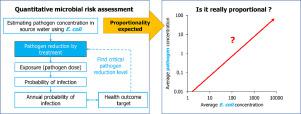Water Research ( IF 12.8 ) Pub Date : 2021-09-25 , DOI: 10.1016/j.watres.2021.117707 Émile Sylvestre 1 , Sarah Dorner 2 , Jean-Baptiste Burnet 1 , Patrick Smeets 3 , Gertjan Medema 4 , Philippe Cantin 5 , Manuela Villion 6 , Caroline Robert 5 , Donald Ellis 5 , Pierre Servais 7 , Michèle Prévost 8

|
Minimum treatment requirements are set in response to established or anticipated levels of enteric pathogens in the source water of drinking water treatment plants (DWTPs). For surface water, contamination can be determined directly by monitoring reference pathogens or indirectly by measuring fecal indicators such as Escherichia coli (E. coli). In the latter case, a quantitative interpretation of E. coli for estimating reference pathogen concentrations could be used to define treatment requirements. This study presents the statistical analysis of paired E. coli and reference protozoa (Cryptosporidium, Giardia) data collected monthly for two years in source water from 27 DWTPs supplied by rivers in Canada. E. coli/Cryptosporidium and E. coli/Giardia ratios in source water were modeled as the ratio of two correlated lognormal variables. To evaluate the potential of E. coli for defining protozoa treatment requirements, risk-based critical mean protozoa concentrations in source water were determined with a reverse quantitative microbial risk assessment (QMRA) model. Model assumptions were selected to be consistent with the World Health Organization (WHO) Guidelines for drinking-water quality. The sensitivity of mean E. coli concentration trigger levels to identify these critical concentrations in source water was then evaluated. Results showed no proportionalities between the log of mean E. coli concentrations and the log of mean protozoa concentrations. E. coli/protozoa ratios at DWTPs supplied by small rivers in agricultural and forested areas were typically 1.0 to 2.0-log lower than at DWTPs supplied by large rivers in urban areas. The seasonal variations analysis revealed that these differences were related to low mean E. coli concentrations during winter in small rivers. To achieve the WHO target of 10−6 disability-adjusted life year (DALY) per person per year, a minimum reduction of 4.0-log of Cryptosporidium would be required for 20 DWTPs, and a minimum reduction of 4.0-log of Giardia would be needed for all DWTPs. A mean E. coli trigger level of 50 CFU 100 mL−1 would be a sensitive threshold to identify critical mean concentrations for Cryptosporidium but not for Giardia. Treatment requirements higher than 3.0-log would be needed at DWTPs with mean E. coli concentrations as low as 30 CFU 100 mL−1 for Cryptosporidium and 3 CFU 100 mL−1 for Giardia. Therefore, an E. coli trigger level would have limited value for defining health-based treatment requirements for protozoa at DWTPs supplied by small rivers in rural areas.
中文翻译:

河流中大肠杆菌与肠道原生动物比例的变化:对基于风险的饮用水处理要求评估的影响
最低处理要求是根据饮用水处理厂 (DWTP) 源水中已确定或预期的肠道病原体水平设定的。于地表水,污染可以直接通过测量粪便指标,如监测参考病原体或间接地确定大肠杆菌(大肠杆菌)。在后一种情况下,用于估计参考病原体浓度的大肠杆菌的定量解释可用于定义处理要求。本研究介绍了对来自加拿大河流提供的 27 个 DWTP 的源水中两年内每月收集的配对大肠杆菌和参考原生动物(隐孢子虫、贾第鞭毛虫)数据的统计分析。源水中的大肠杆菌/隐孢子虫和大肠杆菌/贾第鞭毛虫的比率被建模为两个相关对数正态变量的比率。为了评估大肠杆菌在定义原生动物处理要求方面的潜力,使用反向定量微生物风险评估 (QMRA) 模型确定了源水中基于风险的临界平均原生动物浓度。模型假设的选择与世界卫生组织 (WHO) 饮用水质量指南一致。然后评估平均大肠杆菌浓度触发水平以确定源水中这些临界浓度的敏感性。结果显示平均值的对数之间没有比例关系大肠杆菌浓度和原生动物平均浓度的对数。由农业和森林地区小河流提供的 DWTP 中的大肠杆菌/原生动物比率通常比城市地区大河流提供的 DWTP 低 1.0 到 2.0-log。季节性变化分析表明,这些差异与冬季小河流中大肠杆菌的平均浓度较低有关。为了实现10世界卫生组织目标-6每人每年伤残调整寿命年(DALY),4.0日志的最低削减隐将需要20个DWTPs,和4.0日志的最低减少贾第鞭毛虫会所有 DWTP 都需要。平均大肠杆菌50 CFU 100 mL -1 的触发水平将是识别隐孢子虫临界平均浓度的敏感阈值,但不是贾第鞭毛虫的临界平均浓度。大于3.0个对数更高的处理要求将在与平均DWTPs需要大肠杆菌浓度低至30 CFU 100毫升-1对于隐孢子虫和3 CFU 100毫升-1为贾第鞭毛虫。因此,大肠杆菌触发水平对于确定农村地区小河流供应的 DWTP 中原生动物的基于健康的治疗要求的价值有限。



























 京公网安备 11010802027423号
京公网安备 11010802027423号